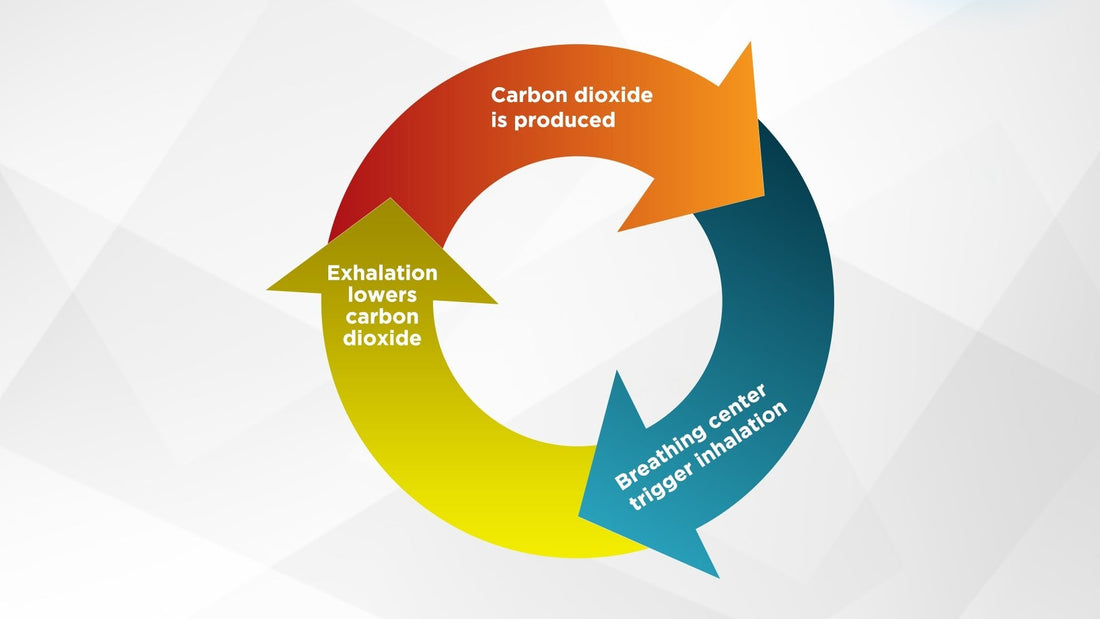
Carbon dioxide controls breathing
The level of carbon dioxide (CO2) in our body is what controls your breathing. When carbon dioxide reaches a certain level, a signal is sent from the breathing center in your brain stem to the breathing muscles, which triggers an inhalation. Upon exhalation, we exhale carbon dioxide and a new breathing cycle starts. Carbon dioxide is produced in your body all the time, and when you breathe, you exhale the excess CO2 that has been built up in our body. The more active we are, the more CO2 is produced. That’s why we breathe more when we are out jogging compared to when we sit in the sofa chilling out.
The exercise CO2OXY Balance Test give an indication of your ability to tolerate carbon dioxide, as well as how high or low the levels of carbon dioxide are, in your body. A low carbon dioxide level, or low tolerance, means that you need to breathe more frequently and/or take in more air during each breath.
Increase your ability to tolerate CO2 with breath training
Normal breathing frequency, at rest, is about 10-12 breaths per minute. Many of us breathe a lot more, often 18-25 breaths per minute. This over breathing means that we are experiencing a low grade form of hyperventilation, which upsets the oxygen and CO2 balance. Thus we end up with too much oxygen in our body, and at the same time, we exhale too much carbon dioxide. At rest, the cells of your body produce around 240 ml of carbon dioxide per minute. The number of breaths per minute shows your ability to tolerate CO2.
Please note that the table below is an oversimplification, as the breathing volume for each breath also needs to be taken in to account. It is merely shown to give you an idea of the concept of CO2 tolerance.
| Breaths/minute | ml CO2 |
|---|---|
| 30 | 8 ml |
| 20 | 12 ml |
| 15 | 16 ml |
| 10 | 24 ml |
| 5 | 48 ml |
The purpose of the 28 Day Breath Training Program is to help you acclimate your body to tolerate higher levels of CO2, which will in turn lead to calmer breathing with fewer breaths per minute.
The reason why it is important to increase your tolerance for CO2 is that this gas has many important functions in your body. For example:
- Antibacterial. A study at the Karolinska Institute in Sweden showed that the growth of staphylococci was 1,000 times higher when the bacteria were exposed to normal air for 24 hours, compared with exposure to air saturated with 100 percent CO2.
- Increased oxygenation. Carbon dioxide forces the oxygen to leave the blood so it can enter into our muscles and organs and be of use. This is called the Bohr effect, after it’s Danish discoverer, Christian Bohr.
- Widens smooth muscles. CO2 has a widening and relaxing effect on our smooth muscles. These muscles are found in our blood vessels, stomach, intestines, bladder, and womb can’t be controlled by our will.
People with COPD or emphysema have high levels of CO2
People diagnosed with COPD (Chronic Obstructive Pulmonary Disease) and emphysema, have severely damaged lung tissue, which makes it hard for the carbon dioxide to be transferred from the blood to the air for exhalation. Therefore, these individuals have high levels of carbon dioxide, despite poor health. However, breath training is still an excellent way of improving their health. When they improve their breathing by using the Relaxator Breath Trainer, for example, the pressure in the lungs increases so that the excess CO2 can be expelled and reset to normal levels.







